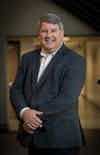 Cordell Eddings
Cordell Eddings
Former Director, Strategic Communications
Published
February 28, 2018
So, we don’t all have flying cars or jetpacks…yet. But that doesn’t mean the aviation industry is resting on its laurels.
It’s been more than a century since man first took to the sky, and the industry is facing new challenges and new opportunities while continuing a ceaseless battle against the laws of physics.
This week, 1,000 of the industry's best minds from the aviation and aerospace industries will get together and dig into some of the biggest issues for the industry at the U.S. Chamber’s 2018 Aviation Summit: Further in Flight.
The 2026 State of American Business
Discover what U.S. Chamber President and CEO Suzanne Clark and leading business leaders are saying about the state of the economy and the top issues shaping the domestic and global business landscape in 2026 and beyond.
But we wanted to know, are they up for creating the future we dream about? Have we seen the best there is? Is aviation innovation dead? So, we asked some of the most influential CEOs and executives in the field that very question, point blank. Here’s what they said:
Kevin McAllister, CEO and President, Boeing Commercial Airplanes

Transformation is underway across the industry and especially at Boeing. We are applying the capabilities of digital technology, advanced manufacturing, and data analytics as we reimagine how commercial airplanes are designed and built. We are improving productivity and efficiency, and simplifying our culture to create a faster, more nimble organization. And we are unleashing the tremendous knowledge, skill, and creativity of our employees to deliver new solutions and capabilities that add value for our customers. The result is that we are continuing to innovate and invest in new product offerings.
Our new 737 MAX 10 is the largest member of the fastest-selling airplane family in Boeing’s history. It combines a new engine, a new winglet, and other improvements to deliver a superior level of efficiency, reliability, and passenger appeal.
Our new 777X family builds on the legacy of the market-leading 777. It is a generational leap in aerodynamic technology with a new wing design and incorporates proven technology from the 787 with new technology to deliver best-in-class fuel efficiency and range to the widebody market.
And the new super-efficient 787-10 is the latest member of a 787 Dreamliner family that is creating remarkable opportunities for airlines to create new city pairs and dramatically improving the air travel experience worldwide.
At Boeing, innovation is alive and thriving and the results speak for themselves!
Allen McArtor, Chairman Emeritus of Airbus Americas, Inc.

If we are done innovating, we may as well not show up for work! Our company–our industry–was founded on new ideas, and continual innovation is why the business continues to thrive.
At Airbus, we apply the latest proven technological developments to optimize the safety and performance of all our products.
And we don’t rely on others to develop those advancements. For example, we created a Silicon Valley outpost, A³, for the sole purpose of devising, proving and implementing out-of-the-box transportation concepts. ‘We Make it Fly’ is not just a literal slogan for Airbus, it is conceptual.
Gary Kelly, CEO of Southwest Airlines

Aviation will continue to innovate, especially with respect to aerospace and information technology. The industry is healthy and competitive, which is where the incentive for innovation begins.
In the near term, there are tremendous opportunities to continue the digital revolution and provide more information, more solutions, and more ease for our employees and our customers.
Over the longer term, we need to continue to strive for more innovative and cost-effective ways to meet the travel demand growth, both on the ground (airports) and in the air (ATC).
Above all, airlines, communities, and the federal government must work together–better–to accelerate the pace of change for the better. Air travel is crucial to our economy and our society, and it is vital that we continue to invest, together, and as a top priority.
Tom Gentile, President and Chief Executive Officer, Spirit AeroSystems, Inc.

With demand for new aircraft exceeding 40,000 over the next 20 years, aviation innovation is more important now than ever before, and it’s happening across the entire supply chain.
It’s obviously critical that we’re innovating around next-generation structures, but we must also be creative and invest resources into innovating around material optimization, tooling, processes, training and other areas that will make us more efficient.
Taking a holistic approach to design and build is the only way we will collectively be able to meet current and future demand for air travel.
Brandon Torres Declet, Chief Executive Officer and Co-Founder of Measure

Innovation in drone technology is changing the scale of aviation, literally and figuratively. With drones, aviation technology is smaller, more nimble, and can operate closer to people and structures. We can use drones for everything from infrastructure inspections and public safety to broadcast media and entertainment.
New software, such as Measure Ground Control, will make it easier to fly safely and manage company drone programs. We expect to see more companies, large and small, become participants in aviation using drone solutions offered by companies like Measure.
Craig Kreeger, CEO, Virgin Atlantic

Innovation will never be over in our industry, as long as it’s underpinned by a simple guiding principle: will it improve customer experience? At Virgin Atlantic we’re driven by finding what works for our customers and take decisions and develop products based on their needs. If we look at an idea that is really cool and innovative but doesn’t fulfill the needs of our customers, we won’t invest in it. The critical consideration in our industry is to have purpose-led innovation; start by asking the right questions–and finding the solutions to those.
Bob Delorge, vice president, transportation and support services of Raytheon

Aviation innovation is going strong across the spectrum. Unmanned aircraft innovations are being proven by companies around the world, big and small. The time of the pilotless commuter plan is almost at hand. We are on the verge of the first supersonic passenger aircraft in a couple generations. Investment, private and public, will soon produce a hypersonic vehicle capable of New York to London travel in 30 minutes.
Airlines are continuing to take advantage of innovation in aircraft design and materials–composites and additive manufacturing, which along with the most modern jet engines result in significant operating efficiencies.
Innovations in low cost, high-speed communication are making it possible for on-demand in-flight entertainment, as well as real-time weather and airspace constraint information in the cockpit on high definition color touchscreen displays. Aviation innovation far from over.
Antonio Campello, President and CEO, Embraer Business Innovation Center

Aviation is rife with disruptive innovations. For example, Embraer is already on its fourth generation application of fly-by-wire technology. This technology, which originally put man on the moon with the NASA Lunar Module and the Space Shuttles, now has applications in our defense, commercial and business jets.
Furthermore, our aircraft maintenance technology now leverages artificial intelligence to deliver prescriptive analytics for optimal fleet operation.
Looking toward the future, we are studying the disruptive innovations that will enable the safe operation and scalability of short-haul electric Vertical Take-off and Landing (eVTOL) aircraft, which will soon revolutionize urban mobility.
About the authors

Cordell Eddings
Cordell was a senior editor and content strategist for the U.S. Chamber of Commerce's strategic communications team. He previously covered corporate finance, economics, foreign exchange and fixed income markets for Bloomberg News in New York during the heart of the financial crisis. Before that, he was a crime and politics reporter (as well as covering many, many country fairs) at the Indianapolis Star.
Bridgett Hebert
Bridgett Hebert is the former director for strategic communications at the U.S. Chamber of Commerce.





